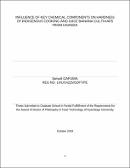| dc.description.abstract | Bananas undergo significant postharvest losses at the farm, during handling, cooking and serving. Loss of palatability and food mass occurs during serving and consumption due to hardening of cooked banana texture. Texture affects sensory properties of bananas and is very important in determining a good cooked banana. Different banana cultivars differ in hardness and the causes for these differences are not well studied particularly among indigenous cooking and juice banana cultivars grown in Uganda.
This study examined influence of key chemical components on hardness of bananas. A total of eleven (11) cooking and three (3) juice banana cultivars grown in and endemic to Uganda, were selected as a case study. Bananas were harvested and used at green mature unripe stage. The samples were analyzed for starch, pectic substances and proximate composition using standard methods, and subsequently assessed the physico-chemical properties of starch and the pectic substances which were the major components. Hardness profile of the 14 banana cultivars was assessed using a texture analyzer. Principle Component Analysis (PCA) revealed that starch and pectic substances were highly and positively correlated with hardness of raw bananas. Then, the role of starch and pectin in influencing hardness of cooked bananas was determined. Sliced bananas were separately treated with pectin, starch and starch-pectin composite before being cooked by steaming combined with mashing and their hardness determined. Pectin was also structurally hydrolyzed from sliced bananas using pectinase (polygalacturonase) and the resulting bananas were cooked in the same way and evaluated for changes in hardness.
According to results, water, starch, and pectic substances were the main components of fresh green mature bananas. Juice bananas yielded significantly more dry matter (30 to 33%) than cooking bananas (P<0.05) which yielded 19 - 25.6% dry matter. Juice bananas yielded significantly more starch (19 to 25%) than cooking banana cultivars (P<0.05) which yielded (4 to 15.2% except one cultivar at 21%). Juice banana cultivars also yielded significantly more crude pectic substances (29.7 to 30.5%) than cooking banana cultivars ((7.5 to 21%) (P<0.05). Other chemical components examined included crude ash (1.97 to 4.24%), crude fibre (0.251 to 0.478%), crude protein (1.23 to 5.64%) and crude fat (0.15 to 0.58%) which did not differ significantly between cooking and juice banana cultivars (P>0.05). The physico-chemical properties (i.e. swelling power, solubility, amylose & resistant starch content and pasting | en_US |

